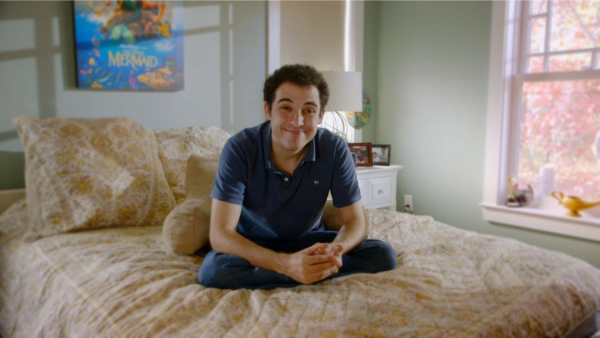Movie review by Greg Carlson
Based on Ron Suskind’s 2014 book “Life, Animated: A Story of Sidekicks, Heroes, and Autism,” the documentary feature “Life, Animated” tells the story of Suskind’s son Owen, who at the age of three withdrew into a nonverbal world that devastated his family. Diagnosed with a Pervasive Developmental Disorder, Owen speaks only what his parents describe as “gibberish” until a viewing of “The Little Mermaid” reveals that Owen is capable of cognitively sophisticated communication through the dialogue of the Disney films that he repeatedly watches. Inspired by the breakthrough, the Suskinds forge ahead, even though a skeptical specialist advocates caution.
Filmmaker Roger Ross Williams closely follows the Suskind quartet, which also includes mother Cornelia and older brother Walt. Supplementing the interviews with footage of scenes chronicling the now grown-up Owen’s move toward greater independence from his parents (including a transition to an apartment of his own), Oscar-winner Williams develops the kind of working relationship with his subject that – even though the artificial presence of the camera never entirely disappears – suggests easygoing, comfortable intimacy. Home video clips of Walt and Owen as youngsters also add to the portrait.
While Owen’s remarkable progress via Disney is the movie’s hook, Owen’s tentative exploration of adulthood, employment, and romance is as engaging as any of the scenes that so bluntly stand in for complementary or parallel emotional beats (like Peter Pan not growing up or the separation of mother and offspring in “Bambi”). A plot involving Owen and his girlfriend Emily is adroitly handled by Williams, who in one memorable exchange at a mini-golf course challenges the wholesome image of Disney’s G-rated depiction of love and sex. A helpful Walt hints that people who kiss one another sometimes use more than their lips. They also use their… “Feelings,” is Owen’s reply.
One of the film’s central thematic concerns parallels the book’s report of Owen’s identification with Disney sidekicks, and Williams enlists the talents of Mathieu Betard, Olivier Lescot, and Philippe Sonrier to supplement the live action material with animated sequences illustrating a fantasy space where Owen interacts with the characters that have long inhabited a special sphere in his life as companions and friends. Back at the Disney viewing and discussion group that Owen organizes, a visit from Jonathan Freeman and Gilbert Gottfried provides another highlight but also raises the question of the notoriously brand-protective Disney’s relationship to “Life, Animated.”
While it is difficult not be caught up in the genuinely moving narrative of Owen’s personal journey, Williams fails to include even the slightest hint of critical counterpoint to the assumption that Disney films represent an unassailable moral position as a kind of righteous elixir. And though the purpose of “Life, Animated” is surely not to open up a critical discourse on the dark side of the corporation’s nearly monolithic historical position of power in key segments of our popular culture, some viewers will yearn for a more nuanced consideration. Fortunately, one’s attitude concerning Disney does not interfere with the movie’s rich understanding of meeting life’s challenges and obstacles with grace, humor, patience, and love.
